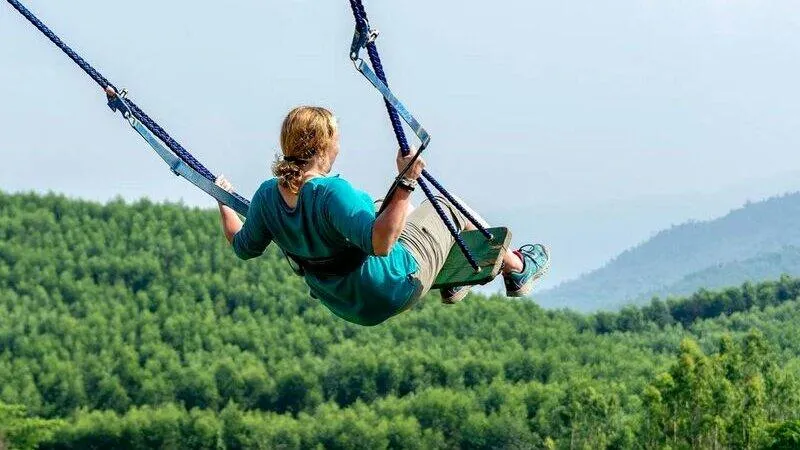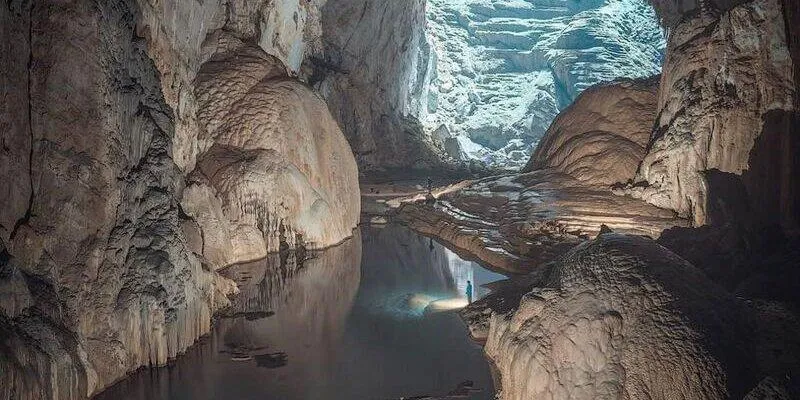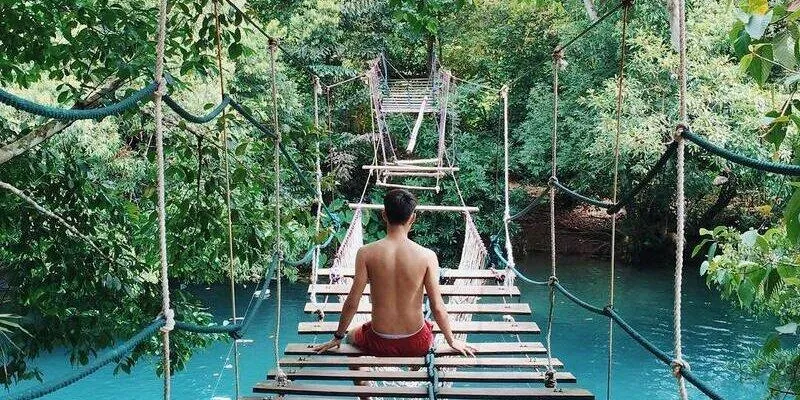Phong Nha – Ke Bang National Park, a precious gem of Vietnam tourism and a UNESCO-recognized World Natural Heritage site, is always a dream destination for nature lovers and adventure enthusiasts. This place not only possesses the majestic and magnificent beauty of mountains and rivers but also hides countless wonders and mysteries within its millions-of-years-old limestone caves. Let’s explore Phong Nha – Ke Bang with “Du lịch khắp thế gian” (Travel Around The World) to fully appreciate the masterpiece of beauty that nature has bestowed upon this central region of Vietnam.
Phong Nha – Ke Bang National Park is not only a famous tourist destination but also a priceless treasure of biodiversity, a powerful testament to the Earth’s long geological history. Coming to Phong Nha – Ke Bang, you will immerse yourself in pristine nature, explore magnificent caves, admire the rich flora, and experience exciting adventure tourism activities.
1. Introducing Phong Nha – Ke Bang National Park: Vietnam’s Natural Treasure
Phong Nha – Ke Bang National Park, located in Quang Binh province, is about 50km northwest of Dong Hoi city center. With a vast area of nearly 123,262 ha of core zone and a buffer zone of 200,000 ha, this national park is one of the largest nature reserves in Vietnam and Southeast Asia.
Phong Nha – Ke Bang was formed millions of years ago, possessing a unique geological structure with a characteristic Karst limestone mountain system, underground rivers, and rich caves. It is divided into two main areas:
- Phong Nha Cave: A typical water cave, known as “The First Cave of the South” with the mysterious and magnificent beauty of its magical stalactite system.
- Ke Bang Area: A majestic limestone mountain region with a dry cave system and diverse primary rainforest.
With its special geological, geomorphological, biological, and cultural values, Phong Nha – Ke Bang National Park was recognized by UNESCO as a World Natural Heritage Site in 2003 and re-recognized with expanded boundaries in 2015.

2. Ideal Time to Explore Phong Nha – Ke Bang
Quang Binh is located in a tropical monsoon climate zone, divided into two distinct seasons: the rainy season (from September to December) and the dry season (from January to August). To have the most complete Phong Nha – Ke Bang exploration trip, the best time to visit is during the dry season, especially from March to August.
Dry Season (March – August):
- Weather: Dry, sunny, little rain, very favorable for sightseeing, cave exploration, trekking, and outdoor activities.
- Landscape: Green nature, clear Son River, suitable for kayaking and sightseeing activities.
- Note: Summer (May – July) can be quite hot, so prepare cool clothes, sunscreen, and hats.
Rainy Season (September – December):
- Weather: Heavy rain, possibly storms, floods, not favorable for tourism activities.
- Note: It is advisable to avoid traveling to Phong Nha – Ke Bang during the rainy season because the weather is unstable and dangerous.
Spring (January – February):
- Weather: Cool, pleasant, but there may still be drizzle.
- Note: Spring is also a good option, but it is necessary to follow the weather forecast to avoid rainy days.

3. Transportation to Phong Nha – Ke Bang
To explore Phong Nha – Ke Bang National Park, you can choose from various means of transportation depending on your starting point and personal preferences:
3.1. Getting to Quang Binh
- Airplane: This is the fastest and most convenient means of transportation, especially if you are far from Quang Binh. Dong Hoi Airport (VDH) has flights from Hanoi and Ho Chi Minh City. From Dong Hoi airport, you can get to Phong Nha by taxi, motorbike taxi, or bus.
- Train: The North – South railway line has Dong Hoi station, you can take the train from Hanoi, Da Nang, or Ho Chi Minh City to Dong Hoi. Dong Hoi station is about 50km from Phong Nha.
- Coach/Bus: Coaches are a popular and cost-effective means of transportation. There are many high-quality coach companies running routes from Hanoi, Da Nang, Hue, Vinh, Ho Chi Minh City to Quang Binh. Dong Hoi bus station is located right in the city center, convenient for traveling to Phong Nha.
- Self-driving car: If you want to freely explore and be proactive with your itinerary, a self-driving car is a great option. The road to Quang Binh is quite easy and the scenery is beautiful.
3.2. Getting from Dong Hoi to Phong Nha – Ke Bang
- Bus: Public bus route B4 from Dong Hoi to Phong Nha has a very cheap fare, about VND 35,000/person. However, buses can be crowded and travel time is longer.
- Taxi, motorbike taxi: Taxis and motorbike taxis are fast and convenient means of transportation, but the cost is higher than buses. Taxi fares from Dong Hoi to Phong Nha range from VND 300,000 – 400,000.
- Motorbike, self-driving car rental: Renting a motorbike or self-driving car is an ideal option for those who want to explore Phong Nha – Ke Bang freely and flexibly. You can rent a car in Dong Hoi or right in the Phong Nha area.
4. Accommodation in Phong Nha – Ke Bang
Phong Nha – Ke Bang has many accommodation options to suit all budgets and preferences, from luxury hotels to cozy homestays and budget-friendly guesthouses.
4.1. Luxury Hotels and Resorts
- Vinpearl Quang Binh: Luxurious 5-star hotel in Dong Hoi, about 50km from Phong Nha.
- Sai Gon Quang Binh Hotel: 4-star hotel in Dong Hoi, with good facilities and services.
- Riverside Hotel – Quang Binh: 3-star hotel in Dong Hoi, with poetic Nhat Le river views.
4.2. Homestays and Guesthouses in Phong Nha
- Phong Nha Farmstay: Famous homestay with green space, close to nature and rural experience activities.
- Pepperhouse Homestay: Lovely, quiet homestay, with unique and friendly design.
- Son Doong Riverside: Hotel and bungalows by the Son River, beautiful views and relaxing space.
- Carambola Bungalow: Small, pretty bungalows, close to nature, affordable prices.
- Phong Nha Coco Riverside: Homestay and restaurant by the Son River, airy space and local cuisine.

5. Must-Visit Destinations When Exploring Phong Nha – Ke Bang
Phong Nha – Ke Bang National Park possesses countless attractive destinations, from magnificent caves to pristine primary forests. Here are some highlights that you should not miss:
5.1. Phong Nha Cave: “The First Cave of the South”
Phong Nha Cave, the symbol of the national park, is a beautiful water cave with a length of nearly 8km. To explore Phong Nha Cave, you will take a boat upstream the poetic Son River, weaving through majestic limestone mountains.
Stepping into the cave, you will be overwhelmed by the magical beauty of the magnificent stalactite system, created by the talented hands of nature over millions of years. Phong Nha Cave is divided into many large and small branches, each branch with a unique beauty, from Bi Ky cave, Cung Dinh cave to Tien cave.
Entrance fees:
- Peak season (April – September): VND 150,000/adult, children free.
- Off-peak season: VND 120,000/adult, children free.
- Sightseeing boat: VND 550,000/boat (12 seats).

5.2. Paradise Cave: “Underground Palace”
Paradise Cave, dubbed the “underground palace,” is one of the longest dry caves in Asia with a length of more than 31km. Paradise Cave impresses visitors with the magnificent and splendid beauty of its diverse stalactite system, illuminated by a modern LED lighting system.
To reach the entrance of Paradise Cave, you will walk or take an electric car through the primary forest, then climb about 500 stone steps. Inside the cave, a winding wooden bridge system helps you easily explore the wonders of the cave.
Entrance fees:
- Peak season (April – September): VND 250,000/adult, VND 125,000/child.
- Off-peak season: VND 200,000/adult, VND 100,000/child.
5.3. Phong Nha – Ke Bang Botanical Garden: Discovering Diverse Ecosystems
Phong Nha – Ke Bang Botanical Garden is a large primary forest with an area of more than 40ha, which preserves the diverse and rich ecosystem of the national park. Coming to the botanical garden, you will trek on trails through the green forest, explore Gio Waterfall, Vang Anh Lake, a seedling nursery, and a display area of rare flora and fauna specimens.
Entrance fee: VND 40,000/adult and VND 20,000/child from 1.1m tall.

5.4. Ozo Park: Adventure Experiences in the Green Forest
Ozo Park is an eco-tourism area located in the heart of the national park, famous for its unique system of adventure games in trees and water. Here, you can try your hand at zipline games, suspension bridges, kayaking, SUP, and especially conquer the 999m zipline challenge over Ozo stream.
Entrance fees:
- Package 1: VND 200,000/adult, VND 100,000/child (sightseeing, tree and water games, mountain biking).
- Package 2: VND 450,000/person (package 1 + 999m zipline, shuttle bus).
5.5. Suoi Nuoc Mooc Ecotourism Area: “Cooling Paradise”
Suoi Nuoc Mooc Ecotourism Area is an ideal destination to cool off and immerse yourself in fresh nature. Suoi Nuoc Mooc is famous for its turquoise stream, flowing from the heart of the limestone mountain, cool all year round. Here, you can participate in water activities such as swimming, kayaking, ziplining, and enjoy local cuisine.
Entrance fees:
- Entrance ticket: VND 65,000/adult, VND 35,000/child from 1.1m tall.
- All-inclusive ticket: VND 110,000/adult, VND 70,000/child from 1.1m tall (including recreational activities).

6. Phong Nha – Ke Bang Cuisine: Rich Local Flavors
Exploring Phong Nha – Ke Bang is not only a journey to admire natural beauty but also an opportunity for you to enjoy delicious Quang Binh specialties, rich in local flavors.
6.1. Banh Loc: Rustic Snack
Quang Binh Banh Loc has a distinctive flavor different from Hue Banh Loc. The cake is made from fresh tapioca flour, filled with shrimp and meat or green beans, steamed in banana leaves. Quang Binh Banh Loc has many types such as leaf-wrapped banh loc, naked banh loc, fried banh loc, each type has a unique flavor.
6.2. Grilled Chicken with Cheo Salt: Mountain Forest Flavor
Grilled chicken with cheo salt is a famous specialty of Phong Nha – Ke Bang. The chicken is selected from garden-raised chickens, with firm and delicious meat. The chicken is grilled over charcoal until golden brown, with crispy skin. The highlight of this dish is cheo salt, a typical dipping salt of Quang Binh, made from salt, green chili, green pepper, lemon leaves, and other spices.
6.3. Chat Chat (Small Clams) Served with Rice Paper: Unique Dish
Chat chat is a type of small clam, living in brackish water areas. Quang Binh chat chat is processed into many delicious dishes, the most famous of which is chat chat served with rice paper. Chat chat meat is stir-fried with onions, spices, served with crispy grilled rice paper.
Some good restaurants in Phong Nha:
- Tuan Ngoc Restaurant: Xuan Tien, Son Trach, Bo Trach, Quang Binh.
- Bo Song Son Restaurant: Main road area to the national park.
- A Vietnam Corner Restaurant: Tourist area within the national park.
7. Important Notes When Exploring Phong Nha – Ke Bang
To have a smooth and safe Phong Nha – Ke Bang exploration trip, you need to note the following:
- Clothing: Choose comfortable, cool, and easy-to-move clothing. You should bring sports shoes or hiking shoes for convenient movement.
- Personal items: Bring hats, sunglasses, sunscreen, insect repellent, raincoat (if traveling in the rainy season).
- Electronic devices: Fully charge your phone, camera and prepare waterproof bags to protect devices when participating in water activities.
- Safety: Comply with safety regulations at attractions, especially when participating in adventure activities. Always wear a life jacket when participating in water activities.
- Environmental protection: Do not litter indiscriminately, maintain general hygiene and respect nature.
Phong Nha – Ke Bang, a world natural wonder, is waiting for you to explore and experience. Plan your trip today to enjoy the majestic beauty and wonders that this place brings.